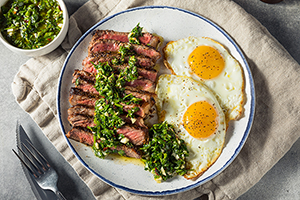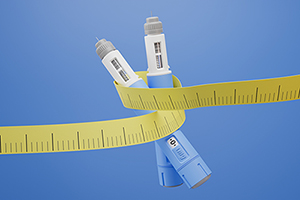



| By Dr. Ronald Hoffman
In previous installments of this series on GERD we’ve discussed the many downsides of acid-blocking medications and why just treating acidity doesn’t get to the root cause of reflux symptoms.
 We’ve also tackled the question of how diet impacts GERD, and shared protocols for tapering off PPI medications like Prilosec, Nexium and Protonix.
We’ve also tackled the question of how diet impacts GERD, and shared protocols for tapering off PPI medications like Prilosec, Nexium and Protonix.
Now let’s take a deep-dive on the science that substantiates the use of certain supplements to help patients break their harmful dependency on acid-blockers.
1) DGL: DGL (deglycyrrhizinated licorice) is one of my favorite remedies for GERD, ulcers, and gastritis. While DGL has not been formally studied for GERD, studies in the 1980s demonstrated its curative effects in gastritis.
Why DGL and not ordinary licorice? While licorice has demonstrable anti-inflammatory effects, it contains a substance, glycyrrhizinic acid, which can cause pseudoaldosteronism. This is a condition where the body retains sodium, loses potassium, and accumulates fluid volume, sometimes resulting in water weight gain and hypertension.
With the advent of deglycyrrhizinated licorice, the anti-inflammatory properties of the herb are retained without risk of pseudoaldosteronism.
The mistake that some people make when taking DGL lozenges is that they fit them in just a couple of times per day between meals. That’s not enough. I find that DGL works best when chewed 6-8 times per day at least ½ hour before, or 2 hours after meals.
2) Endefen: I consider Endefen to be one of the most valuable weapons in my arsenal against GERD. Usually, I’m wary of multi-ingredient supplements for GI problems because of the potential for intolerance of one or another of the constituents, but the formulators of Endefen seem to have gotten it just right. It’s a powder that dissolves in water, creating a gloppy mix that coats the esophageal lining. At the Hoffman Center we generally dose it twice daily away from meals; a serving taken near bedtime seems to be particularly effective.
What’s in Endefen? Plantain and apple pectin are mucilaginous substances that soothe the esophageal mucosa; cinnamon, a traditionally-used anti-bacterial and wound healer, offers cooling effects; EGCG from green tea and astaxanthin provide antioxidant and anti-inflammatory benefits; Arabinogalactins from larch bark stimulate the immune system and serve as a prebiotic to foster helpful bacteria that synthesize healing short-chain fatty acids; and D-mannose, familiar from its application to UTIs, suppresses mucosal adhesion of harmful bacteria.
3) Melatonin: Considerable research validates the benefits of melatonin in GERD. Melatonin is best known as a sleep aid and circadian rhythm regulator. It is manufactured by the pineal gland, located deep within the brain.
But a little known fact is that the gastrointestinal tract contains up to 400 times more melatonin than is secreted by the pineal gland. Research demonstrates that melatonin has the ability to suppress excess acid production; it also shields the GI lining from the destructive effects of free radicals caused by stress, toxic agents, or ulcer-causing drugs like NSAIDs.
A recent study showed that melatonin outperformed Zantac and boosted the effectiveness of Prilosec in alleviating symptoms and preventing tissue damage in patients with GERD.
The researchers summarized: “From the results of our study, it can be concluded that melatonin could be used in the treatment of GERD either alone or in combination with omeprazole. The combination therapy of both melatonin and omeprazole is preferable as melatonin accelerates the healing effect of omeprazole and therefore shortens the duration of treatment and minimizes its side effects.”
The suggested dose of melatonin for GERD is 3-6 mg at bedtime.
4) Iberogast: A popular German formulation used extensively in Europe for treatment of dyspepsia (indigestion), Iberogast is a liquid combination of the herbs Iberis amara, Angelica, Chamomile, Caraway Fruit, St. Mary’s Thistle, Balm Leaves, Peppermint Leaves, Celandine, and Licorice Root. Together, they exert anti-inflammatory, anti-spasmodic, anti-bacterial and pro-motility effects. The latter makes Iberogast particularly helpful for GERD. By including certain herbal bitters which are traditional digestive aids, Iberogast promotes optimal gastric emptying and intestinal transit, alleviating the stuck feeling that many GERD sufferers experience. Due to its dual anti-bacterial and pro-motility effects, Iberogast is ideal for sufferers of SIBO (small intestine bacteria overgrowth), a frequent contributor to the reflux and sour eructations of heartburn sufferers. WARNING: Contains peppermint, which is thought to provoke GERD in some individuals.
5) Aloe: Another traditional remedy for gastrointestinal ailments, aloe is most familiar as a home remedy for burns. Hence, its application to esophageal inflammation. For aloe to work best, it’s preferable to use the gel form, in generous amounts, away from food. I generally suggest ¼ cup of a purified aloe gel product like Lily of the Desert 3 or 4 times daily away from meals, on arising, or at bedtime.
It’s important to source a product that has minimal sugar, flavoring ingredients, or harmful additives, and that has areduced content of aloin which might have laxative or irritant effects on the GI tract.
In a recent study, aloe syrup was found to be comparable to Zantac and Prilosec in relieving symptoms of GERD, and was well-tolerated.
6) Probiotics: No formal studies have been done on administering probiotics for GERD, but it stands to reason that easing dysbiosis might relieve out-of-control bacterial proliferation, which can lead to upper intestinal gas and upward reflux of stomach contents.
On a purely anecdotal level, I can share that dosing some of my GERD patients with higher doses of Dr. Ohirra’s Probiotics(4 capsules twice daily), which can be chewed and swallowed, has alleviated their symptoms. After a couple of weeks, upon obtaining symptom relief, you can revert to a maintenance dose of one capsule twice daily.
7) Acidify: Among the more controversial theories about GERD is that it may be the result, not of too much stomach acid, but of too little. This condition is called hypochlorhydria, and it’s known to be common in individuals over 50, especially women. According to this theory, popularized by Dr. Jonathan Wright and others, lack of stomach acid results in poor motility, and incompletely digested food gets stuck in the stomach, causing reflux.
There may be something to this, as adequate acidification of the stomach can be a signal for stomach emptying, enabling food to transit to the small intestine. On the other hand, the strategy can backfire: Some GERD sufferers report worsened pain when they take acid supplements like betaine hydrochloride as a digestive aid prior to meals.
The Heidelberg test, which involves swallowing a small radio-transmitting capsule that monitors pH of the GI tract, is said to be a way of diagnosing hypochlorhydria. But having previously used it for many years, I find it unreliable, expensive, and with potential risks of perforating the lower GI tract if a patient suffers from diverticulosis. It’s safer and more cost-effective to undertake a simple trial of a capsule or two of betaine HCl prior to meals (some patients prefer a tablespoon or two of apple cider vinegar) to see if they ease GERD symptoms, or cause the discomfort to worsen.
With the suggestions I’ve provided here, along with proper diet and a very cautious, slow taper, it should be possible for the majority of patients taking powerful acid-blockers to successfully wean themselves.
Though we think of declining estrogen as the hallmark of menopause, it's actually common for…

Up to 12 percent of Americans have ulcers at some point in life. Peptic ulcers…
Gallbladder disease is a modern illness. An estimated 20 million Americans have gallbladder disease. The…

Dr. Antonio Bianco, recipient of the American Thyroid Association’s John B. Stanbury Thyroid Pathophysiology Medal,…

There’s a misconception among low-carb dieters. Many people believe a low-carb diet is much higher…

New, more powerful weight loss drugs: Drugs like Wegovy, Rybelsus, Ozempic and Mounjaro/Zepbound are revolutionizing…

The Cannabinoid Connection: How CBD Transforms Pet Care and Human Health, Part 1

Our virtual voicemail is open 24/7, so there's no need to wait to submit your questions for Dr. Hoffman. Leave a message, and you may hear your question featured on the Intelligent Medicine radio program!